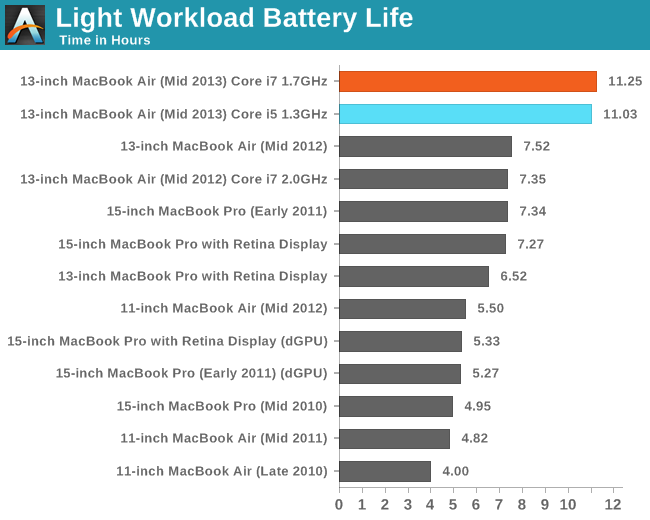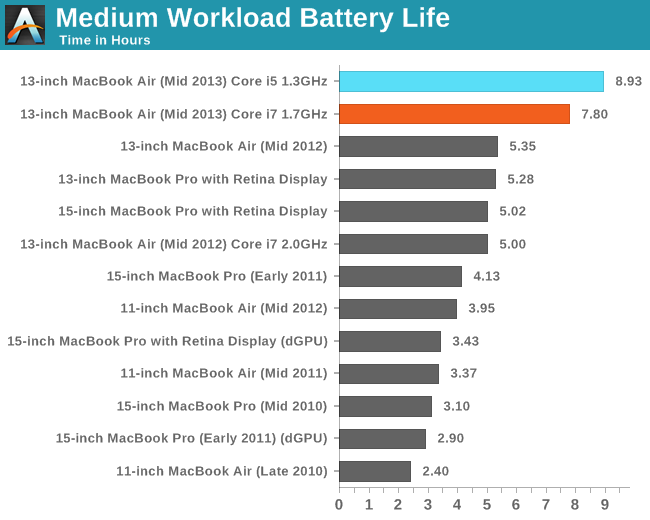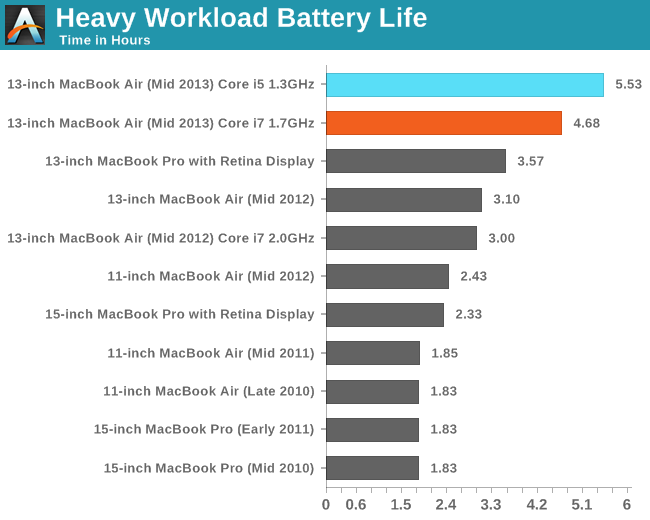The 2013 MacBook Air: Core i5-4250U vs. Core i7-4650U
by Anand Lal Shimpi on July 4, 2013 8:00 AM ESTBattery Life
I ran the i7-4650U based 13-inch MBA through the same suite of battery life tests as the un-upgraded base model. What's important to note about all of these tests is that the amount of work done per cycle of the test doesn't vary based on performance. There's enough idle time baked in to make sure that the Core i7 based 13-inch MBA isn't artifically penalized by having to do more work than the i5 model simply because it's faster. The other thing I noticed while testing these two machines is that although both were equipped with the exact same Samsung panel, their brightness curves were slightly different. At the same brightness setting under OS X (or Windows 8), both panels responded differently. Both were capable of similar max brightness values but it's clear that either Apple is doing some calibration here that's panel lot specific or there's a significant variance in how these panel/backlight/electronics combinations respond (or both).
I reproduced the battery life test details below:
The light and medium suites are inherently related - they use the same workload and simply vary the aggressiveness of that workload. The light test hits four different websites every minute, pausing for nearly the entire time to simulate reading time. Flash is enabled and present on three of the sites. The long pause time between page loads is what really makes this a light test. Web browsing may be the medium for the test but if all you’re doing is typing, watching Twitter update and maybe lazily doing some other content consumption this is a good representation of the battery life you’ll see. It’s a great way of estimating battery life if you’re going to be using your notebook as a glorified typewriter (likely a conservative estimate for that usage model).
The medium test hits the same webpages (Flash and all) but far more aggressively. Here there’s less than 10 seconds of reading time before going onto the next page. It sounds like a small change but the impact on battery life is tremendous.
Both the light and medium tests are run in their default state with processor graphics enabled, as well as with the discrete GPU forced on. I run with the dGPU on as well because it’s far too often that a single application open in the background will fire up the dGPU and contribute to draining your battery. The goal here is to deliver useful numbers after all.
The final test is very similar to our old heavy multitasking battery life tests, but with some updates. Here I’m downloading large files at a constant 1MB/s from a dedicated server, while playing back a looped 1080p H.264 movie (the Skyfall trailer) all while running the medium battery life test. The end result is a workload that gives you a good idea of what a heavy multitasking usage model will do in terms of battery life. I’ve found that OS X tends to fire up the dGPU anyway while running this workload so I saw no reason to run a separate set of numbers for processor and discrete graphics.

In our mostly idle workload, there's virtually no difference between the two parts in terms of battery life. The i7-4650U is actually able to boast a slightly higher number here but for all intents and purposes the two are equal. Apple's 12 hour estimate comes from a slightly lighter workload than what we run, so I see no reason that Apple couldn't claim equivalent max battery life regardless of what CPU option you pick.

Under load we begin to see the expected: the Core i7 upgrade does have a power cost associated with it. There's around a 13% reduction in battery life here compared to the standard 13-inch MBA configuration. Heavier workloads tend to force the CPU cores into higher frequency (and thus higher voltage) states. In the case of the i7 both the frequency and voltages are higher, which drives power consumption higher than the i5 resulting in lower battery life.

The gap between the i5 and i7 grows to its largest point in our heaviest workload, which makes sense. Here there's around an 18% reduction, or almost a full hour of battery life (52 minutes). If you ran both processors at full tilt nonstop (think looped Cinebench until both batteries die) you'd probably see an even larger gap. In this case I think the differences here are pretty reasonable expectations for most target usage models of the MacBook Air.
Thermals
As the MacBook Air isn't a handheld tablet, the limit for what's an acceptable max skin temperature is much higher. Just as there's an impact on battery life with the Core i7, there's also an impact on thermals. I ran a CPU and GPU intensive workload and measured thermals at three different points on the system: max temperature on the keyboard side of the system (upper left corner of the keyboard), max temperature on the bottom of the machine as well as the max temp reported by the CPU core proximity thermistor.
| 13-inch MacBook Air (Mid 2013) CPU Comparison - Observed Temperatures | ||||
| Location | Keyboard/Top | Bottom (sustained) | Bottom (max) | Internal CPU Proximity Thermistor |
| Intel Core i5-4250U | 47.1 °C | 41.4 °C | 41.4 °C | 92.2 °C |
| Intel Core i7-4650U | 47.7 °C | 42.1 °C | 46.6 °C | 96.7 °C |
Average temperatures aren't substantially higher on the i7, however you will notice that there's a column for max observed temperature on the bottom of the chassis where the upgraded MacBook Air does show a considerably higher temperature. The higher temp isn't sustained but I did record occasional blips up to 46.6 °C on the bottom of the chassis while the i5 model pretty much topped out at its sustained temperature. Internal temps are obviously much higher as well.
The impact on acoustics wasn't really noticeable. Under extended load both systems hit the same 6500 RPM fan speed, which given the same cooling system produced identical acoustic profiles. I tried to see if the i7 would ramp to 6500 RPM any quicker than the i5 but in most cases I don't believe it did, at least appreciably so.










127 Comments
View All Comments
eanazag - Friday, July 5, 2013 - link
Zero innovation? I am neither for or against. Though how often do companies release a new product missing features that they had enough time to roll out. Apple is fairly consistent at rolling out products with a technology first. Name another laptop with a PCIe SSD. There are a handful with AC WiFi. And Apple is on the front end of anyone releasing a design with Haswell. I am not going to ignore that the fact is the chassis is the same, but they weren't doing bad with it to begin with. The reality is that to hit 12 hours of battery life the performance was about the same as last year's model. The question was for someone buying a Mac, was there even an option that didn't destroy the battery life gains.The "best Mac laptop" article was geared towards consumers buying a Mac. It wasn't for everyone. I would not buy a Mac today. Gaming is not adequate for me and buying a title that can still run on my Windows desktop at the same time is a better choice.
I would only buy Macs for specific use cases. Maybe editing media. Though I do like Sony Vegas on the PC.
Finally, there are articles that I routinely skip because the topic doesn't interest me much at all. I would suggest you develop that skill as it will likely help you in life more than being a complainer.
jack daniels esq - Friday, July 5, 2013 - link
God - I love this f**cking sitenegativeions - Saturday, July 6, 2013 - link
It's amazing how many anandtech and apple losers post on here. Don't you morons know that these people are just company PR. Apple rips people off blind. Are their computers nice to use. Sure. I love them. But Apple are goons.antonio22m - Wednesday, August 14, 2013 - link
Macbook Air is undoubtedly a very good notebookPrice and lack of optical drive can affect a large number of users whose decision during the judgment can be negative so that they can decide to choose another manufacturer.
Air is perfect and the best "second computer" that you can wish for.
His task was not to be the main and only computer we can possess.
If you want excellent laptop computer that will be able to carry it with you wherever you go, the Air is an excellent choice for perfectly reasonable size and more pronounced weight that barely exceeds one kilo.
Take a look at this comparison at http://www.squidoo.com/apple-macbook-air-133 and You will see comparison to the another Apple laptops.Anyone considering purchasing this laptop needs to see the information in this chart.
helloworldv2 - Thursday, July 4, 2013 - link
In my opinion, your light workload battery life test doesn't represent real life. Under my perceived light load usage (Word open, a few tabs in Firefox, running a few algorithms in terminal), I've seen 7-8 h battery life with the maxed out 13" model..DanNeely - Thursday, July 4, 2013 - link
Everyone's idea about what is a light workload is different. A few years ago when my Laptop of the time was benched on AT, I was able to beat their light load numbers by about 10-15% on a test that was much less demanding than the current one.melgross - Thursday, July 4, 2013 - link
We all have our own workloads. Anand, and other testing sites make these loads up to represent what they think is approximately the average for light, medium and heavy workloads. For your usage, you seem to fall to the medium workload, even though you call it light.For others, light is just using a browser with a handful of tabs.
The poi t to their workloads is to have a standard that they can compare machine to machine. Don't take it as more than that, and for somethi g that people can look at and figure where their workload falls within the least and the max tests.
FwFred - Thursday, July 4, 2013 - link
What is your screen brightness? A few algorithms? Is this code which continuously runs (not good for CPU power management)? If anything, Anand is getting on the lower end of the range others are seeing, primarily because he sets his screen to 200 nits which is higher than others.helloworldv2 - Thursday, July 4, 2013 - link
Brightness is on auto. A few algorithms might be anything between querying a sequence database and making multiple sequence alignments or whatever, utilizing both cores 100% for a brief period. Nothing too heavy (that's what ssh and clusters are for).FwFred - Thursday, July 4, 2013 - link
I have a 2011 MBA, and while the brightness is using the 'auto' selection, you can still set the percentage. Which percentage do you have it? The auto setting will vary the backlight based on the ambient light, but the percentage still affects the result. I am at ~70%, and I can say that 100% is very noticeably brighter.